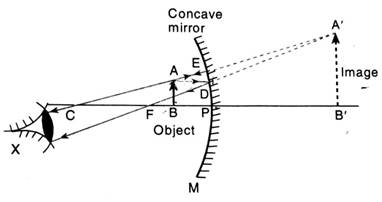Draw the ray diagram to show the formation of image by a concave mirror of focal length 15 cm for the following positions of object. (Diagrams may not be drawn to the scale.)
Indicate is placed at 30 cm from mirror.
a. object is placed at 30 cm from mirror.
b. object is placed at 10 cm form the mirror.
a. object is placed at 30 cm from the
mirror.
Here focal length PF = 15 cm
Object distance PC = 30 cm
PC = twice the focal length = 2×15
When the object is placed at 30 cm from pole i.e. at the centre of curvature, an incident ray parallel to principal axis reflects at mirror and passes through the focus, Second ray of light passing through focus reflects at mirror and passes parallel to the principal axis. These both reflected ray DA’ and EA’ meet at a point A’. We draw A’B’ perpendicular to the principal axis which is the real and inverted image of the object.
Image is of same size as object.
A’B’ = -AB
Image distance v = 30 cm

b. object is placed at 10 cm form the mirror
We are given that focal length f is 15 cm, so if object distance is 10 cm then object must be between the pole and the focus.
In the given figure,
Object distance is BP = 10 cm
PF = 15 cm
Light ray AD from the object which is parallel to axis gets reflected at D and passes through focus F and ray AE passes through centre of curvature after striking the concave mirror. Both reflected rays EC and DF are diverging. When these reflected rays are produced backwards, they intersect at A’ behind the concave mirror. Then we draw A’B’ perpendicular to axis thus A’B’ is the virtual image of the object.

We know that mirror formula is:
![]()
![]()
![]()
![]()
![]()
B’P = v = -30 cm
Here image distance is 30 cm behind the mirror. The image formed will be virtual and erect.![]()
![]()
Magnification = 3
A’B’ = 3 × AB
So, image is enlarged 3 times to the size of the object.